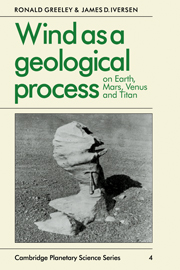Book contents
- Frontmatter
- Contents
- Preface
- 1 Wind as a geological process
- 2 The aeolian environment
- 3 Physics of particle motion
- 4 Aeolian abrasion and erosion
- 5 Aeolian sand deposits and bedforms
- 6 Interaction of wind and topography
- 7 Windblown dust
- Appendix A Nomenclature and symbols
- Appendix B Small-scale modeling of aeolian phenomena in the wind tunnel
- Glossary
- References
- Index
4 - Aeolian abrasion and erosion
Published online by Cambridge University Press: 16 November 2009
- Frontmatter
- Contents
- Preface
- 1 Wind as a geological process
- 2 The aeolian environment
- 3 Physics of particle motion
- 4 Aeolian abrasion and erosion
- 5 Aeolian sand deposits and bedforms
- 6 Interaction of wind and topography
- 7 Windblown dust
- Appendix A Nomenclature and symbols
- Appendix B Small-scale modeling of aeolian phenomena in the wind tunnel
- Glossary
- References
- Index
Summary
Introduction
Anyone who has experienced a sand storm is acutely aware of the effectiveness of windblown sand as an agent of abrasion. Every year countless cars and trucks are caught in sand storms where, in exposures sometimes as short as a few minutes, windows can be frosted and paint can be stripped to bare metal. Multiply this high rate of abrasion over geological time and some appreciation can be gained of the effectiveness of wind erosion (Fig. 1.5).
Wind erosion takes place either through abrasion, the wearing away of relatively solid rock or indurated sediment, or through deflation, in which loose particles, such as sand, are blown away. Wind erosion commonly occurs through windblown particles that act as abradants – the agents of wind erosion.
In this chapter we first discuss the mechanics of wind abrasion on the microscopic scale and review the formation of ventifacts. We then present results from various laboratory simulations and estimate rates of wind abrasion on Earth and Mars. In the last section we discuss large wind-eroded landforms.
Aeolian abrasion of rocks and minerals
Studies of wind abrasion have generally been carried out either by materials scientists and engineers who are concerned with problems such as the abrasion of turbine blades by airborne particles, or by geologists who are concerned with the erosion of rock materials. Engineering studies typically are well documented and quantitative, but do not usually involve materials appropriate for geological applications. And, although geological studies involve analyses of rock abrasion, most of these studies are qualitative or, at best, only partly quantitative for terrestrial environments; thus the results are not appropriate for extrapolations to other planets.
- Type
- Chapter
- Information
- Wind as a Geological ProcessOn Earth, Mars, Venus and Titan, pp. 108 - 144Publisher: Cambridge University PressPrint publication year: 1985



